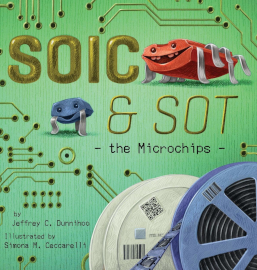Three children’s picture books in the SOIC and Friends series introduce children to the world of electronics and engineering. The three books work best read in order:
- SOIC & SOT - the Microchips
- TSSOP Gets Zapped - with Static Electricity
- MSOP & DPAK – One Hot Day
Rather than writing information books, author Jeffrey Dunnihoo gives computer chips personalities and feelings, creating storylines that engage young readers. In the first book, two microchips go through the assembly process and discover their purposes. In the second book, static electricity plays havoc with electronic components in a photo printing kiosk. In the third book, an extremely hot day stresses the components within a little girl’s computer, and the components work together to avoid damage from overheating.
These books are written and illustrated in a way that makes them accessible to preschoolers on the story level, while older children will pick up information about topics such as circuit boards, manufacturing, soldering, and interactions between chips as they perform their functions. Scientific and manufacturing concepts are embedded in the stories rather than taught directly. The full-page illustrations with overprinted text make them as visually appealing as some of the best picture books.
The last two books add several pages at the end that provide more direct instruction on key concepts, and the second book includes a few experiments with static electricity. Supplemental material for the first book, including videos from manufacturers, is available free online. The extra material buttresses the stories and further develops the topics at a level that should interest older students. For example, the third book (on overheating) explains and illustrates how heat damages electronics and includes a simple description of the design of a microchip. Parents and teachers can choose if and when to use the additional material.
The concept behind these books is great, as are the illustrations. I like the introduction to microchips in the first book, but I thought the topic of static electricity in the second book was the least effective for a few reasons. Students today might never encounter a photo kiosk since people more typically store photos in the cloud or on their phone or print them themselves. Also, while electronic damage from static electricity is a real issue, it's not of much concern to young children. I’d love to see the author tackle topics more likely to occur with children, like damage to tablets when they are dropped, a mobile phone that has trouble connecting to the internet, or difficulty printing something out from a phone or tablet.
Summary
The SOIC and Friends books should be very useful for introducing modern technology in an entertaining fashion.














